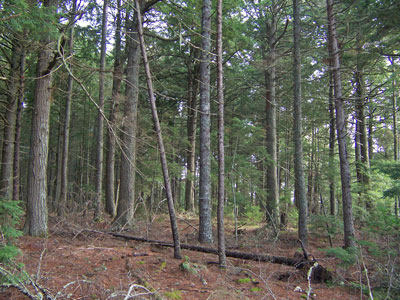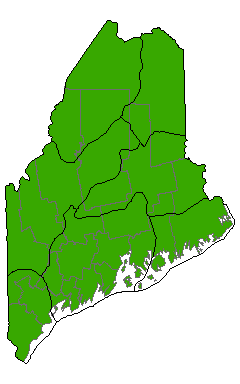DACF Home → Bureaus & Programs → Maine Natural Areas Program → Communities, Plants, and Animals → Natural Community Fact Sheets → White Pine Forest
Printer Friendly Fact Sheet - 1.1 MB pdf (Get a free copy of Adobe Acrobat Reader)
White Pine Forest
Scientific Name: White Pine - Mixed Conifer Forest; State Rank: S5

- Community Description
- Soil and Site Characteristics
- Diagnostics
- Similar Types
- Conservation, Wildlife and Management Considerations
- Distribution
- Characteristic Plants
- Associated Rare Plants
- Associated Rare Animals
- Examples on Conservation Lands You Can Visit
Community Description: This is a closed canopy forest type in which white pine is dominant. Occasionally red spruce, red pine, hemlock, or (coastally) northern white cedar may be nearly co-dominant with the white pine; in fact, because the pine trees tend to be larger and the other trees smaller, the smaller trees may be more numerous. In many of these forests, the dense and strongly coniferous canopy limits understory growth. Shrub cover is rarely >20% and the herb layer rarely exceeds 30%. The herb layer can include a spotty mixture of s such as lowbush blueberry, forbs, or ferns, but graminoids are very uncommon. Canada mayflower is frequent. The ground layer is mostly conifer litter, with bryoid cover <25%; large hair-cap moss and red- stemmed moss are common species. Back to top.
Soil and Site Characteristics: This type occurs on sandy to loamy mesic soils (usually well drained, occasionally imperfectly drained or very well drained), often with a slowly decomposing duff layer of conifer needles. Soils are generally shallow (<40 cm) and moderately acidic (pH 5.0-6.0). These forests are usually at low elevations (<900') on slopes or coarse-textured flats. Back to top.
Diagnostics: White pine is dominant (>33% cover); red oak and northern hardwood species (beech, sugar maple, yellow birch) total <25% cover. The heath shrub and herbaceous layers are sparse. Back to top.
Similar Types: Red and White Pine Forests have >33% cover of red pine. Hemlock Forests have more hemlock than white pine. Where red spruce is co-dominant, this type can grade into Spruce - Fir forest types. Oak - Pine Forests and Oak - Northern Hardwoods Forests have red oak at > 33% cover. Back to top.
Conservation, Wildlife and Management Considerations: Demand for white pine has considerably reduced mature, undisturbed examples of this type. Most sites known to be of high ecological quality lack formal protection. Maintaining the surrounding lands as forest is important in conserving particular stands of this type, particularly given that many known examples are small (<50 acres).
This community type may be used as nesting habitat by a number of coniferous or mixed forest specialist bird species such as the sharp-shinned hawk, pine warbler, black-throated green warbler, blackburnian warbler, and red crossbill. Back to top.
Distribution: Statewide, less common northward; extends in all directions from Maine. Landscape Pattern: Large Patch. Back to top.


Characteristic Plants: These plants are frequently found in this community type. Those with an asterisk are often diagnostic of this community.
- Canopy
- Eastern hemlock*
- Northern white cedar
- Red maple
- Red spruce
- White pine*
- Sapling/shrub
- Balsam fir
- Hemlock
- Beaked hazelnut*
- Red maple*
- Red spruce
- White pine*
- Wild-raisin*
- Dwarf Shrub
- Lowbush blueberry*
- Swamp dewberry*
- Herb
- White pine*
- Hemlock
- Balsam fir
- Canada mayflower*
- Starflower
- Bryoid
- Dicranum moss*
There are no documented examples of rare plants associated with this natural community.
There are no documented examples of rare animals associated with this natural community.
Examples on Conservation Lands You Can Visit
| Example | County |
|---|---|
| Bearce Lake, Moosehorn National Wildlife Refuge | Washington Co. |
| Bigelow Preserve Public Lands | Franklin Co. |
| Chamberlain Lake Public Lands | Piscataquis Co. |
| Gero Island Public Lands | Piscataquis Co. |
| Scientific Forest Management Area, Baxter State | Piscataquis Co. |